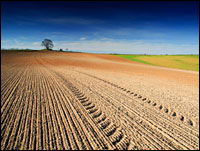 In the article “A Perennial Search for Perfect Wheat” in yesterday’s New York Times science section, writer Jim Robbins highlights one of the slow-moving global disasters of our age: the destruction of the world’s soils. This in turn is part of a wider problem: global ecosystem destruction, including depleted oceans, cleared forests, and overgrazed grasslands.
In the article “A Perennial Search for Perfect Wheat” in yesterday’s New York Times science section, writer Jim Robbins highlights one of the slow-moving global disasters of our age: the destruction of the world’s soils. This in turn is part of a wider problem: global ecosystem destruction, including depleted oceans, cleared forests, and overgrazed grasslands.
As for erosion, Robbins writes:
Erosion is the big problem. Scientists say that an average of 12 tons of soil are lost per acre per year to water erosion, and high winds can take a whopping 50 tons of top soil from an acre of bare wheat field in just 24 hours …
When the soil has no cover of vegetation — a period of months to more than a year — the wind blows across the rolling hills here and sucks the fine-grain soil into the sky. It creates giant clouds and an eerie brown darkness in the middle of the day…On many exposed hilltops here, all of the soil has been stripped away down to clay …
“It’s a gift of the ice age and a wonderful cocktail of different rocks and minerals, and if you add organic material, great for plant growth,” Mr. Warren [managing director of the Land Institute in Kansas] said of the soil. “Without it, we’d be Australia, which didn’t have a good ice age.”
In other words, this is a classic case of drawdown, a concept first introduced to the public by William Catton Jr. in his 1980 book, Overshoot. Drawdown is the ecological equivalent of taking money out of your savings account and using it as income. Not only is it unsustainable, it actually decreases the carrying capacity of the ecosystem, that is, the capacity of the ecosystem to sustain life.
The reason for interest in perennial crops — that is, plants that stay alive all the time, versus annuals, which die and must be reseeded every year — is that annuals have many disadvantages:
Annual wheat, for example, needs help from herbicides to ward off invasive species, because it cannot compete with weeds, and it is less naturally pest resistant. It does not use nitrogen efficiently, so half of the nitrogen fertilizer applied runs off, polluting streams and groundwater … “You name an abuse from farming,” Mr. Warren said, “from soil erosion to the use of hydrocarbons to pesticides and herbicides, and we can get rid of it with perennial crops.”
On top of this:
Crops on the ground throughout the year would also bank substantially more carbon than a field that is plowed every year would, which helps global warming. Researchers at the Land Institute estimate annual crops cause the loss of about 40 percent of the total carbon in the soil.
So we see how many of the world’s long term problems interact in feedback loops: fossil fuels are dumped on land using annuals, destroying the life-giving soils, worsening global warming, and setting up a system that we depend on for food which will collapse when fossil fuel supplies collapse. Fixing this will probably require not only perennial plants but relocalization of agriculture and a complete restructuring of the agricultural system.
 In the article "
In the article "

